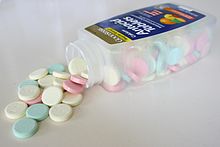Antacid

An antacid is a substance that
Medical uses
Antacids are available
Non-particulate antacids (sodium citrate) increase gastric pH with little or no effect on gastric volume, and therefore may see some limited use in pre-operative procedures. Sodium citrate should be given within 1 hour of surgery to be the most effective.[6]
Side effects
Conventional effervescent tablets contain a significant amount of sodium and are associated with increased odds of adverse cardiovascular events according to a 2013 study.[7] Alternative sodium-free formulations containing magnesium salts may cause diarrhea, whereas those containing calcium or aluminum may cause constipation.[8]: Table 2 Long-term use of antacids containing aluminum may increase the risk of developing osteoporosis.[9] In vitro studies have found a potential for acid rebound to occur due to antacid overuse, however the significance of this finding has been called into question.[10][11]
Properties of antacids
When an excess amount of acid is produced in the
Antacids do not directly inhibit acid
Interactions

Antacids are known to
A proposed method to mitigate the effects of stomach acidity and chelation on drug absorption is to space out the administration of antacids with interacting medications by at least two hours,[15] however this method has not been well studied for drugs affected by urine alkalization.[13]
There are concerns regarding interactions between delayed-release tablets and antacids, as antacids may increase the stomach pH to a point at which the coating of the delayed-release tablet will dissolve, leading to degradation of the drug if it is pH sensitive.[14]
Formulations
Antacids may be
Liquids
Several liquid antacid preparations are
Tablets
Chewable tablets
Some common American brands are Tums, Gaviscon chewable tablets, and Maalox chewable tablets.[18]
Effervescent tablets
Effervescent tablets are tablets which are designed to dissolve in
Brand names
Some brands include Alka-Seltzer, Gaviscon, Tums, Gelusil and Eno.[25][26][27]
References
- ^ from the original on 5 November 2021. Retrieved 24 November 2020.
- ^ "Aluminum hydroxide and magnesium carbonate Uses, Side Effects & Warnings". Drugs.com. Archived from the original on 20 May 2021. Retrieved 24 November 2020.
- ^ a b c "Consumer Summary – Treatment Options for GERD or Acid Reflux Disease: A Review of the Research for Adults". U.S. Department of Health & Human Services. Agency for Healthcare Research and Quality. 23 September 2011. Archived from the original on 11 October 2014.
- S2CID 10640940.
- PMID 28045707.
- PMID 24284017.
- ^ PMID 35343261.
- ^ "Taking Antacids". Medline Plus. U.S. Department of Health and Human Services, National Institutes of Health, U.S. National Library of Medicine. 7 November 2014. Archived from the original on 5 July 2016.
- PMID 2644821.
- S2CID 10897187.
- PMID 22242022.
- ^ S2CID 36875514.
- ^ PMID 31788764.
- ISBN 978-0-6485158-6-9.)
{{cite book}}: CS1 maint: location missing publisher (link - ^ Thompson WG (12 September 2014). "Antacids". IFFGD Publication #520. International Foundation for Functional Gastrointestinal Disorders, Inc. (IFFGD). Archived from the original on 6 May 2016.
- S2CID 8133980.
- ^ "Maalox Antacid Oral: Uses, Side Effects, Interactions, Pictures, Warnings & Dosing". WebMD. Archived from the original on 24 June 2022. Retrieved 24 June 2022.
- ^ Dubogrey I (2013). "Putting the Fizz into Formulation". European Pharmaceutical Contractor. No. Autumn. Archived from the original on 28 August 2021. Retrieved 17 April 2017.
- ^ "Tablets". British Pharmacopeia. 2003. Archived from the original on 3 January 2013.
- ISBN 978-92-4-156301-7. Retrieved 1 July 2013.
- ^ "Alka Seltzer Directions of use, Sodium & Aspirin content – Alka Seltzer relief from Headaches, Migraine & Upset stomach". alkaseltzer.ie. Archived from the original on 29 April 2015. Retrieved 17 April 2017.
- ISBN 978-0471238966.
- PMID 3511824.
- ^ "Which OTC Meds Treat Heartburn?". WebMD. 30 March 2023. Retrieved 8 January 2024.
- ^ "Eno – Summary of Product Characteristics at eMC". Electronic Medicines Compendium. Retrieved 2 September 2016.
Last updated 1 January 2016
- ^ "Gelusil - Uses, Side Effects, and More". Retrieved 27 February 2024.
External links
![]() The dictionary definition of antacid at Wiktionary
The dictionary definition of antacid at Wiktionary
